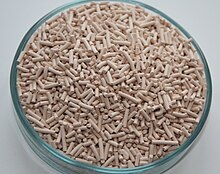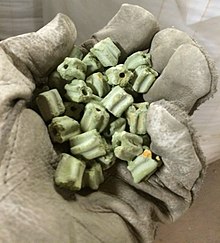Catalysis
For example, Wilkinson's catalyst RhCl(PPh3)3 loses one triphenylphosphine ligand before entering the true catalytic cycle.In cooperative catalysis, chemical species that improve catalytic activity are called cocatalysts or promoters.The external stimuli used to switch the catalyst can include changes in temperature, pH, light,[20] electric fields, or the addition of chemical agents.In Upjohn dihydroxylation, the sacrificial catalyst N-methylmorpholine N-oxide (NMMO) regenerates OsO4, and only catalytic quantities of OsO4 are needed.[22] Diverse mechanisms for reactions on surfaces are known, depending on how the adsorption takes place (Langmuir-Hinshelwood, Eley-Rideal, and Mars-van Krevelen).For example, the catalyst for the Haber process for the synthesis of ammonia from nitrogen and hydrogen is often described as iron.In this way the particularly strong triple bond in nitrogen is broken, which would be extremely uncommon in the gas phase due to its high activation energy.Supports can also be used in nanoparticle synthesis by providing sites for individual molecules of catalyst to chemically bind.Supports are porous materials with a high surface area, most commonly alumina, zeolites, or various kinds of activated carbon.One common type of fuel cell electrocatalyst is based upon nanoparticles of platinum that are supported on slightly larger carbon particles.When in contact with one of the electrodes in a fuel cell, this platinum increases the rate of oxygen reduction either to water or to hydroxide or hydrogen peroxide.[28] Many homogeneous catalysts are however not organometallic, illustrated by the use of cobalt salts that catalyze the oxidation of p-xylene to terephthalic acid.Organocatalysts are supposed to operate akin to metal-free enzymes utilizing, e.g., non-covalent interactions such as hydrogen bonding.The Nobel Prize in Chemistry 2021 was awarded jointly to Benjamin List and David W.C. MacMillan "for the development of asymmetric organocatalysis."[29] Photocatalysis is the phenomenon where the catalyst can receive light to generate an excited state that effect redox reactions.Most biocatalysts are enzymes, but other non-protein-based classes of biomolecules also exhibit catalytic properties including ribozymes, and synthetic deoxyribozymes.In biocatalysis, enzymes are employed to prepare many commodity chemicals including high-fructose corn syrup and acrylamide.Estimates are that 90% of all commercially produced chemical products involve catalysts at some stage in the process of their manufacture.Many fine chemicals are prepared via catalysis; methods include those of heavy industry as well as more specialized processes that would be prohibitively expensive on a large scale.The term "catalyst", broadly defined as anything that increases the rate of a process, is derived from Greek καταλύειν, meaning "to annul", or "to untie", or "to pick up".The concept of catalysis was invented by chemist Elizabeth Fulhame and described in a 1794 book, based on her novel work in oxidation–reduction reactions.[8][9][38] The first chemical reaction in organic chemistry that knowingly used a catalyst was studied in 1811 by Gottlieb Kirchhoff, who discovered the acid-catalyzed conversion of starch to glucose.He developed Döbereiner's lamp, a lighter based on hydrogen and a platinum sponge, which became a commercial success in the 1820s that lives on today.[44] Vladimir Ipatieff performed some of the earliest industrial scale reactions, including the discovery and commercialization of oligomerization and the development of catalysts for hydrogenation.[45] An added substance that lowers the rate is called a reaction inhibitor if reversible and catalyst poisons if irreversible.Thus, a poison that covers the surface randomly will tend to lower the number of uncontaminated large planes but leave proportionally smaller sites free, thus changing the hydrogenation vs. hydrogenolysis selectivity.Promoters can cover up the surface to prevent the production of a mat of coke, or even actively remove such material (e.g., rhenium on platinum in platforming).[52] Original: Jag skall derföre, för att begagna en i kemien välkänd härledning, kalla den kroppars katalytiska kraft, sönderdelning genom denna kraft katalys, likasom vi med ordet analys beteckna åtskiljandet af kroppars beståndsdelar medelst den vanliga kemiska frändskapen.Translation: I shall, therefore, to employ a well-known derivation in chemistry, call [the catalytic] bodies [i.e., substances] the catalytic force and the decomposition of [other] bodies by this force catalysis, just as we signify by the word analysis the separation of the constituents of bodies by the usual chemical affinities.







Catalyst (disambiguation)CatalistCathalistisCatabolismair filtercarbon monoxidecarbon dioxideformaldehydechemical reactionintermediateshomogeneousheterogeneousEnzymeschemical industryElizabeth Fulhamehydrogen peroxideoxygenmanganese dioxideeffervescencecatalaseSI derived unitturnover numberenzyme unitcatalytic cyclereaction mechanismactivation energynitric oxideheterogeneous catalysishydrogentitanium dioxideScanning tunneling microscopyadsorptiondissociationdiffusewater molecule dimersdesorbstransition stateenergy profileelementary reactionchemical equilibriumthermodynamicssecond law of thermodynamicsGibbs free energyperpetual motion machinehydrolysisesterscarboxylic acidprecatalystsWilkinson's catalystinduction periodtandem catalysisautocatalysisaspirinalcoholosmium tetroxideUpjohn dihydroxylationN-methylmorpholine N-oxidehomogeneous or heterogeneoushomogeneous catalysisreactantzeolitereactantssolidsliquidreaction mixturezeolitesaluminatransition metaloxidesRaney nickelvanadium(V) oxidesulfur dioxidesulfur trioxidecontact processreactions on surfacesLangmuir-HinshelwoodEley-Ridealvan KrevelenHaber processammonianitrogenadsorbtriple bondsulfuric acidsupportedactivated carbonsilicon dioxidecalcium carbonatebarium sulfateElectrocatalystelectrochemistryfuel cellhalf reactionsnanoparticlesplatinumcarbonelectrodeshydroxideesterificationmethyl acetateacetic acidmethanolhydroformylationhydrosilylationhydrocyanationorganometallic catalystsp-xyleneterephthalic acidOrganocatalysisamount of substancehydrogen bondingprolinethiourea organocatalysissubstratebindingPhotocatalysisexcited stateSinglet oxygendye-sensitized solar cellsEnzyme catalysismetabolismribozymesdeoxyribozymesmembranebiocatalysishigh-fructose corn syrup